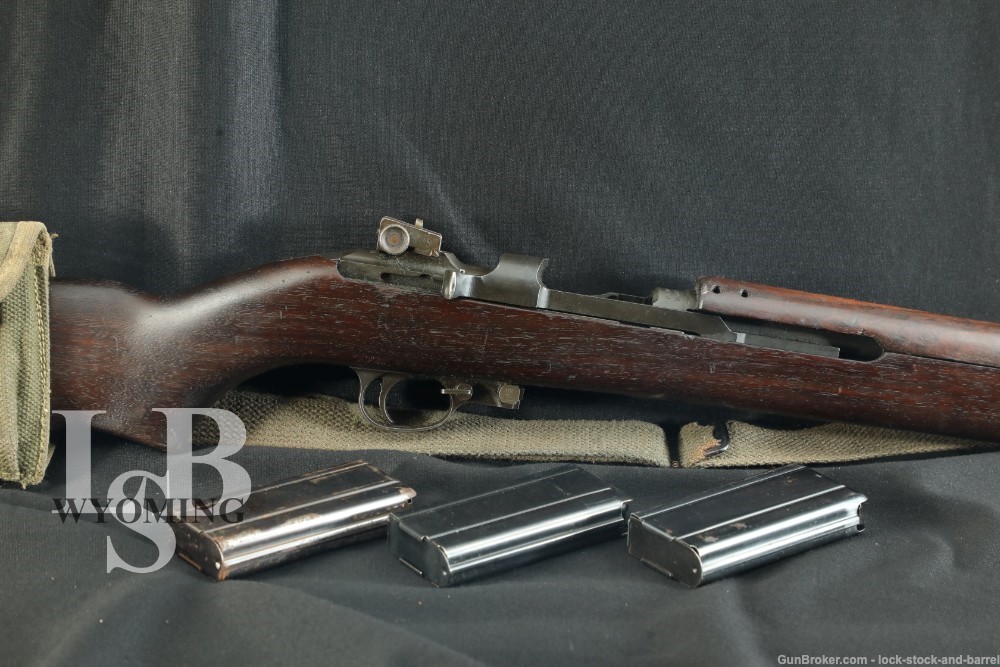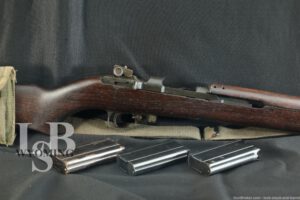
WWII Early Inland Division General Motors .30 Cal M1 Carbine August 1943
SOLD FOR: $1,325.00
WOA#: WY240515CF010
Make: Inland Division of General Motors
Model: M1 Carbine
Serial Number: 600390
Year of Manufacture: Receiver 1943, Barrel Date 8-1943
Caliber: .30 Cal Carbine
Action Type: Semi-Automatic carbine fed by detachable magazines.
Markings:
The top of the receiver is marked, “U.S. CARBINE CAL. 30 M1 / INLAND DIV. 600390”.
The magazine release is marked “M / AD”.
The rear sight is marked “SA” and an Ordnance stamp.
The Lug is unmarked
The stock is marked “PU” in the sling cut, it also has a reproduction stamp with a boxed “G.H.D. / U.E.F.” with the crossed cannons on the right side of the stock. UEF originally stood for Underwood Elliot Fisher. The original stamp did not contain the periods between U E and F.
The right side of the trigger group is marked with the Inland Logo.
The left side of the hammer is marked with a slightly faded “W”
The slide is marked with a “D”
The flip style safety is marked “E.I.”.
The Bottom of the barrel is stamped with a series of proofs, and an import mark from “SHERWOOD NORTHRIDGE, CA.” The top of the barrel is marked “P” about mid length, the end of the barrel is marked “INLAND MFG. DIV. / GENERAL MOTORS / 8-43”
The front sight is unmarked.
The upper handguard is stamped “H.I.” on the inside.
The type 4 barrel band is stamped “KI”
The front of the gas block is stamped “I-1”
Barrel Length: 18″
Sights / Optics: The front sight is a fixed blade set between two protective ears. The rear sight is the later style sliding aperture sight dovetailed to the receiver.
Stock Configuration & Condition: The stock is an Oval cut, Low wood, stock, with a four rivet handguard, type three barrel band with bayonet lug, a later style flip safety safety and a checkered metal Buttplate. The LOP measures about 13.25” from the front of the trigger to the back of the buttplate. The wood shows very minor compressions, marrs, and scratches scattered throughout. There are no chips or cracks in the wood. The refinished metal buttplate has mostly sharp checkering with some minor marks and a few small patches of patina. Overall the stock rates in about Very Good condition for C&R.
Magazine Quantity & Condition: This rifle includes three 15 round magazines. Two of the magazines are in Very good condition. The third magazine is in Poor condition; it has lost its finish and is covered in surface rust.
Type of Finish: Parkerized
Finish Originality: Original
Bore Condition: The bore is bright with well defined rifling. There is no visible erosion in the bore. In this writer’s opinion the bore rates 8/10.
Overall Condition: This rifle retains about 95% of its metal finish. The metal surfaces show patina scattered throughout. The friction surfaces on the receiver and bolt show the majority of the wear. The trigger guard has turned brown with patina as well. Overall, this rifle rates in about Very Good condition for C&R.
Mechanics: The action functions correctly. We did not fire this rifle. As with all used firearms, a thorough cleaning may be necessary to meet your maintenance requirements.
Box, Paperwork & Accessories: This rifle includes the three magazines, green canvas sling and a Green canvas double magazine carrier attached to the stock marked “U.S. 1943”.
Our Assessment: During the early stages of World War II, the U.S. military recognized the need for a lightweight rifle that would bridge the gap between the heavy and cumbersome M1 Garand rifle and the standard issue sidearm, the M1911 pistol. The goal was to provide troops with a compact and easy-to-handle firearm that offered more firepower than a pistol but was lighter and more maneuverable than a full-size rifle. In 1941, the U.S. Army’s Ordnance Department contracted with various manufacturers, including Winchester and General Motors’ Inland Division, to develop and produce the M1 Carbine. The rifle was designed by a team led by firearms designer David Williams, who drew inspiration from the successful M1 Garand and the short-recoil action of the M1 Thompson submachine gun. The M1 Carbine featured a gas-operated, semi-automatic action and fired a .30 caliber cartridge known as the .30 Carbine. The cartridge, while less powerful than the standard .30-06 ammunition used in the M1 Garand, offered greater capacity and reduced recoil, making it more controllable and well-suited for short to medium-range engagements. The M1 Carbine saw widespread use in World War II, becoming a staple firearm for American troops. It was praised for its reliability, ease of use, and versatility. The rifle was not only issued to U.S. forces but also provided to allied nations through various lend-lease programs. After World War II, the M1 Carbine continued to serve in the Korean War and saw limited use in subsequent conflicts. It also became popular among civilian shooters and collectors due to its historical significance and manageable recoil. Overall, the M1 Carbine played a significant role in U.S. military history, offering a lightweight and reliable firearm that filled a niche between pistols and full-size rifles. Its compact design, firepower, and ease of use made it a favored weapon among soldiers in various roles and contributed to its enduring legacy. This example has an early receiver and barrel set, but later style rear sight, barrel band, upper handguard and safety. This example also appears to have been re-imported by Sherwoods Int’l Imports in Northridge CA. Please see our photos and best of luck with your bidding!!!-R.L.

